|
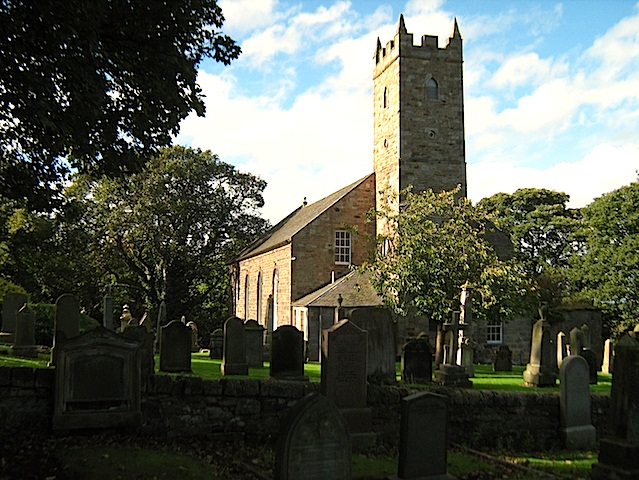 “The memory of great men is no less useful
than their presence.”
George, 4th Earl of Winton. “The memory of great men is no less useful
than their presence.”
George, 4th Earl of Winton.
 The
town of Tranent's original Brythonic name, Travernant, meaning "settlement on
the ridge overlooking a ravine", tends to show there was a settlement there in
the 8th century. Local legend has it that a chapel dedicated to St. Martin of
Tours and was associated with Lindisfarne in the 8th century. The
town of Tranent's original Brythonic name, Travernant, meaning "settlement on
the ridge overlooking a ravine", tends to show there was a settlement there in
the 8th century. Local legend has it that a chapel dedicated to St. Martin of
Tours and was associated with Lindisfarne in the 8th century.
In 1145, Tranent Parish Church was
established by a charter from the Archdeacon, Thor, Son of Swan in 1150, and the
Church came under the jurisdiction of Holyrood Abbey.
The grant was confirmed by Richard,
Bishop of St. Andrew, and later by baron Saer de Quincy. The parsonage remained
with the Abbey and although a vicarage settlement took place in 1251, the church
was frequently served by canons from Holyrood.
The oldest record relating to the
subject is of about the year 1145, when Thor or Thorald, the son of Swan,
confirmed to the canons-regular of St. Augustine of the Abbey of Holyrood House,
founded by King David in 1128, the church of Tranent, reserving the rights of
Walleran, the chaplain, during his life.
The canons enjoyed the church, with
its rights and revenues, which were very considerable, until the Reformation.
The parish was served by a vicar, who had the " small " tithes for his support.
In 1222 we find one John exercising the office, their progressive part seems to
have been played prior to the days of Wish- art, Knox, and Melville. All
through, that family are said to have been
bitterly and resolutely opposed to the Reformation.
This Thor or Thorald, son of Swan,
died in 1154. It would appear that with him the family ended, and that, in
accordance with feudal usage, the property reverted to the Crown, and
consequently came into the possession of King Malcolm IV, called 'the Maiden'.
The next proprietor of these lands was Robert de Ouincy, a Northamptonshire
baron, who acquired them from William the Lion in 1165. To him succeeded, first,
Saher de Quincy, his elder son, and afterward his younger son Roger.
Roger de Ouincv was Earl of
Winchester in England as well as Lord of Tranent in Scotland, of which he was
Constable in right of his wife Helen, the eldest daughter of Alan, Lord of
Galloway. Roger died, leaving three daughters co-heiresses. The eldest daughter,
Margaret, married William de Ferrers, Earl of Derby, who got by her the Barony
of Tranent ; the second, Elizabeth, married Alexander Comyn, Earl of Buchan in
Scotland, and brought him the Constableship, besides Elphinstone, Myles, and
some other part of Tranent; Ela, the youngest, married Sir Allan la Zouche of
Ashby, and brought as her share the lands of Fawside and the mines and miners of
Tranent.
These ladies were first-cousins of
John Balliol, and their husbands naturally sided with him in the contest for the
crown against the Bruces. When the latter won, King Robert gave their estate ad
it's chapel to his kinsman and companion-in-arms, Alexander de Seton,
whose family had for several generations possessed the neighboring lands of
Seton and Winton.
Following the de Quincy forfeiture,
the barony of Tranent and it's chapel passed to the Seton's who adding the title
of it's barony of Tranent to that of Seton, and it remained with the powerful
house of the Lords Seton, later Earls of Winton, for upwards of six hundred
years until 1715-16. While the Lords Seton themselves maintained the
private Collegiate Church of Seton on the nearby Seton Estate, the church of
Tranent was greatly patronized by the family and all of the related lesser
branches of the House, such as the Seton's of Falside, Greendykes, Monkmylne,
Myles, St. Germains, Tranent, etc.
The building was later described as
'above the average style of country edifices' and consisted of three
oblong buildings, a vaulted stone covered roof, interior archways and a square
tower rising from the centre. There are also canonical records of a chapel,
dedicated to St. Peter, situated on the ridge overlooking a coal-bearing ravine
at Travernant, however the church was badly damaged in 1544 and 1547, by the
forces of the Earl of Hertford during the incident of "the Rough Wooing",
although functionally restored by George 7th Lord Seton, and his sons and
grandsons. The Church joined the Scottish Reformation when Thomas Cranstoun, the
first minister took over from the evicted canons and the last Roman Catholic
priest, Thomas Moffat; the church of St. Peter was now a reformed Protestant
church.
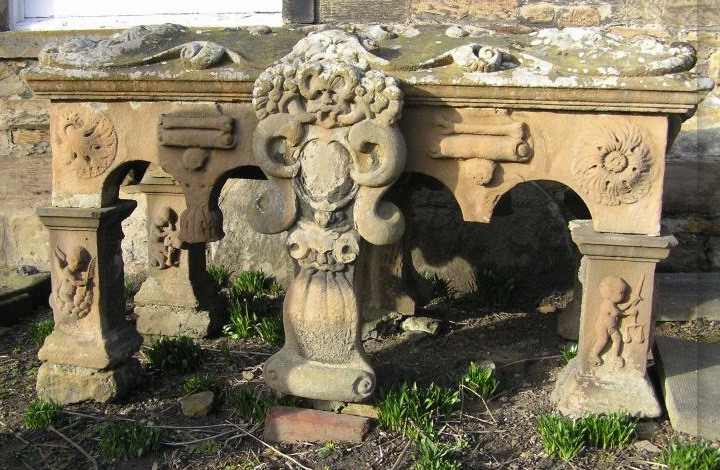 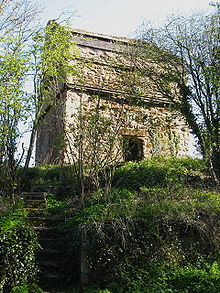 The
church remained a ruinous condition, after Somerset's attack, into the 17th
century and, though it was again refurbished, it is not known when. The church
was said to have been restored, extended and improved throughout, but in 1799
the decision was made to build a new church, which was opened in 1800, a church
which still stands high above the ravine overlooking the Firth of Forth. The
church remained a ruinous condition, after Somerset's attack, into the 17th
century and, though it was again refurbished, it is not known when. The church
was said to have been restored, extended and improved throughout, but in 1799
the decision was made to build a new church, which was opened in 1800, a church
which still stands high above the ravine overlooking the Firth of Forth.
At a total cost of over 10,000
pounds, the church was extensively refurbished and refurnished in 1954. The
congregation had to meet in the town hall during the work, but the church they
returned to is much the same as it is today. The church is a category B listed
building.
The present Tranent Parish Church
was built by John Simpson, Mason, and has many distinguishing features including
round headed windows and battlements, and pyramidal corners on the upper floor.
The interior was completely recast in 1953, when a stained glass venetian west
window was added.
Some features of the previous
building still remain, including the priest’s door and the lower courses of
pre-Reformation walling. There are also two buttresses and the ruined mortuary
aisle of the Cadells of Cockenzie, which projects from the north wall and
features a window, with circled heads, dating from the sixteenth century.
The churchyard still features a good
collection of unusual monuments, including the Seton Tomb-Table, Baillie George
Seton's Monument, and David Seton's Doocot, dated 1587, situated to the north of
the churchyard of Tranent, and separated from it only by a road, , now empty but
which had been constructed to accommodate 1122 pairs of pigeons. Above the now
doorless doorway of the dovecot is a tablet of sandstone is still to be seen,
which at one time bore a shield but is now all but effaced by time and the
weather, yet still bearing the name of DAVID SETOUN, and the date, 1587,
distinct and legible.
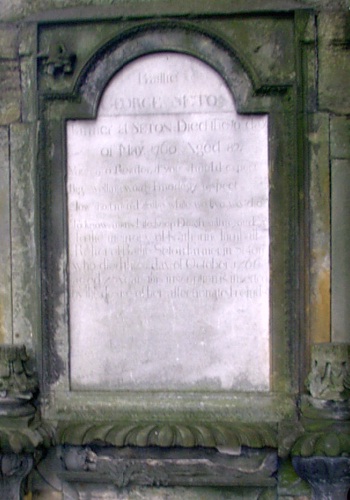 David
Seton was Deputy Baillif of Tranent and Baillie of Cockenzie, having long
resided at Winton Place in nearby Tranent in what was known as the hotel, the
"Royal George", and was Chamberlain to Robert Seton,
8th Lord Seton and 1st Earl of Winton. The nearby Cockenzie House in Port Seton
was built for him by Robert Seton, 8th Lord Seton and 1st Earl of Winton, circa
1600, as an estate-residence from which to oversee the affairs of the harbour
and of the local Seton estate. David Seton is of course most known for his
involvement in the trials of witches at Tranent. David
Seton was Deputy Baillif of Tranent and Baillie of Cockenzie, having long
resided at Winton Place in nearby Tranent in what was known as the hotel, the
"Royal George", and was Chamberlain to Robert Seton,
8th Lord Seton and 1st Earl of Winton. The nearby Cockenzie House in Port Seton
was built for him by Robert Seton, 8th Lord Seton and 1st Earl of Winton, circa
1600, as an estate-residence from which to oversee the affairs of the harbour
and of the local Seton estate. David Seton is of course most known for his
involvement in the trials of witches at Tranent.
Tranent Parish Church served as the parish church for
Cockenzie and Port Seton up to 1839 when the Auld Kirk
was built. However the Cockenzie parishioners continued to
be buried in Tranent kirkyard prior to Prestonpans cemetery
becoming available to local people. The Tranent Parish
Church Hall is now located in the former Wishart Church,
Church Street.
BURIAL ENCLOSURE: portion of the medieval church, laterally
serving as a burial enclosure to Cadell family of Cockenzie.
Curtain walls with harl-pointing, sections of ashlar coping
and decorative wrought-iron railings. Blocked round arched
2-light window with chamfered reveals. Various wall
monuments within, including ornate Baroque armourial
monument to Andrew Barclay and his wife, Katherine Cooper.
Sash and case windows; small-pane glazing patterns, in
decorative form in round arched windows. Grey slates. Ashlar
coped skews and crenellations.
INTERIOR: re-ordered Leslie Grahame Thomson, 1953, galleries
removed. Shallow depressed arch vault; white painted walls
and ceiling, blue in lower chancel to W. Circular
ventilation grilles. Single aisle. 3 pedimented oak
doorcases. Simple oak furnishings including pews.
Wrought-iron sanctuary lamps. Stained glass in Venetian
window, Margaret Chilton with Marjorie Kemp and John Blyth,
1953; S window by William Wilson, 1966. Timber stair to
tower.
GRAVEYARD WALLS, PIERS, GATES, RAILINGS AND MONUMENTS:
rubble walls to graveyard with substantial buttresses to N
terraced wall; some rubble and ashlar coping. Wrought- and
cast-iron gates. Droved ashlar gatepiers to SE. Various fine
munuments in graveyard, dating from 15th and 16th centuries,
mostly 18th and 19th century. Outstanding table and wall
monuments and gravestones, replete with Memento Mori and
Baroque details.
" The following tombstones, that of Seton to the right and
that of Vallance to the left of the entrance from the new to
the old churchyard, seem to have been the most beautiful
ever erected within these grounds. The fact of the Seton
shield, &c, being elaborately carved on the former,
indicates that he to whose memory the stone was raised being
a scion of the House of Winton. Inscription as follows : —
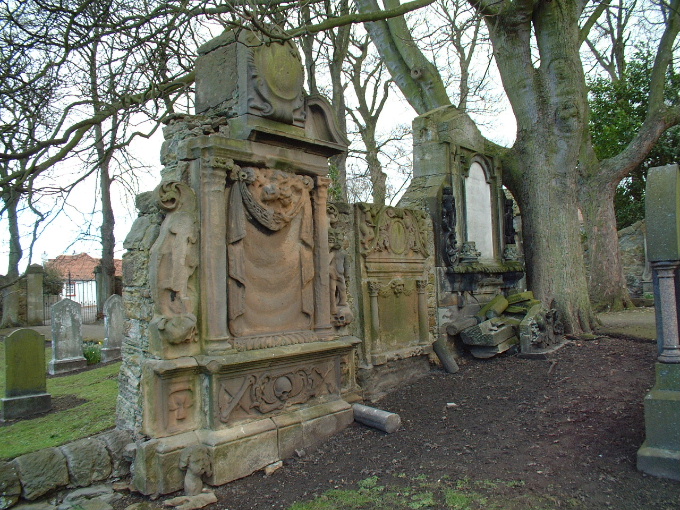 Memorial to
George Seton,
of the family of St.
Germains, Bailie of Tranent: Memorial to
George Seton,
of the family of St.
Germains, Bailie of Tranent:
Bailie George Seton, Farmer at Seton,
Died the 10th day of May 1760, aged 82.
You err, O reader, if you should expect
Big swelling words, immodesty, respect
How short man's life, 'las, while we live we
To know man's life, keep death still in your eye. —
To the memory
Of Catherine Turnbull, relict of George Seton, Farmer in
Seton, who died Oct. 5th, 1766, Aged 73 years.
The Seton arms, cornucopias, cherubs,
skulls, harvesters, etc., adorn this memorial, but its
symbolic interest centers mainly on the striking
representation of Death depicted on its lower portion. This
figure lies robed within a bier whose side it clutches with
a grisly hand, its utter realism and intense expression
reaching a level rarely attained.
Another old stone, supported by four stout pillars with
sculptural adornments, is that of Hutchison, but originally
erected by an Karl of Winton to some one of his family, as
seen by the earliest inscription, which is to a " William
Seton, Tenant in Seton," who died in 1706, and to Agnes, his
spouse.
The Hutchisons,
to whom the place of sepulture now belongs, claim descent
from the House of Seton. Captain William Hutchison, who was
Governor of Cape Coast Castle in Africa, and died when at
home on a visit in 1832, is buried here, as also Captain
George Hutchison, R.N.. He was uncle to the Misses
Hutchison, living at Seton Lodge, Tranent, in 1889. The
Seton arms are cut in stone over the
entrance to the Lodge. Another tombstone, of 1700, recalls '
' Adam Persone, Shoemaker and Tanner in Seton, reminding us
of the bright little village of that name which so long
existed beside the castle.
|

